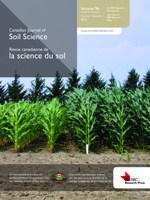Keys, K., Sterling, S. M. and Guan, Y. 2015. Using historic soil survey data to map water erosion hazard for land-use planning in Nova Scotia. Can. J. Soil Sci. 95: 299-304. A fine-scale digital soil map layer for Nova Scotia was combined with historic soil survey information and digital elevation (DEM) data to generate a new water erosion hazard map based on inherent soil erodibility and slope class. Results showed approximately 62% of Nova Scotia has low erosion hazard, 33% has moderate hazard, and 5% has high hazard. The erosion hazard map was subsequently used in a provincial watershed assessment program (NSWAP) to map potential water quality stressors related to land-use patterns on erodible soils. This work is an example of how historic soil survey data can be utilized to create new information for land-use planning and environmental assessment.
How to translate text using browser tools
10 July 2015
Using historic soil survey data to map water erosion hazard for land-use planning in Nova Scotia
Kevin Keys,
Shannon M. Sterling,
Yue Guan
ACCESS THE FULL ARTICLE
It is not available for individual sale.
This article is only available to subscribers.
It is not available for individual sale.
It is not available for individual sale.
<
Previous Article
|

Canadian Journal of Soil Science
Vol. 95 • No. 3
August 2015
Vol. 95 • No. 3
August 2015
Cartographie
érosion hydrique
mapping
Nouvelle-Écosse
Nova Scotia
qualité de l'eau
soil




